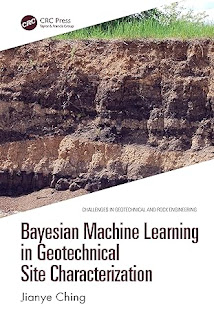Bayesian Machine Learning in Geotechnical Site Characterization
Jianye Ching ... 188 pages - Language: English - Publisher: CRC Press; (August, 2024).
Bayesian data analysis and modelling linked with machine learning offers a new tool for handling geotechnical data. This book presents recent advancements made by the author in the area of probabilistic geotechnical site characterization.
Two types of correlation play central roles in geotechnical site characterization: cross-correlation among soil properties and spatial-correlation in the underground space. The book starts with the introduction of Bayesian notion of probability “degree of belief”, showing that well-known probability axioms can be obtained by Boolean logic and the definition of plausibility function without the use of the notion “relative frequency”. It then reviews probability theories and useful probability models for cross-correlation and spatial correlation. Methods for Bayesian parameter estimation and prediction are also presented, and the use of these methods demonstrated with geotechnical site characterization examples.
Bayesian data analysis and modelling linked with machine learning offers a new tool for handling geotechnical data. This book presents recent advancements made by the author in the area of probabilistic geotechnical site characterization.
Two types of correlation play central roles in geotechnical site characterization: cross-correlation among soil properties and spatial-correlation in the underground space. The book starts with the introduction of Bayesian notion of probability “degree of belief”, showing that well-known probability axioms can be obtained by Boolean logic and the definition of plausibility function without the use of the notion “relative frequency”. It then reviews probability theories and useful probability models for cross-correlation and spatial correlation. Methods for Bayesian parameter estimation and prediction are also presented, and the use of these methods demonstrated with geotechnical site characterization examples.





